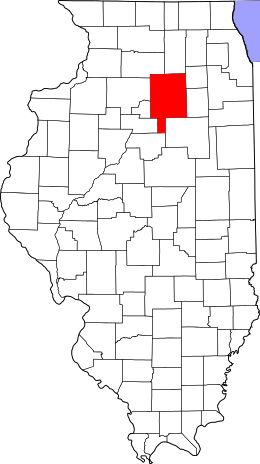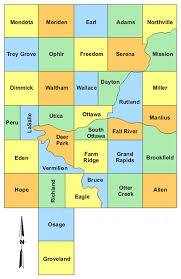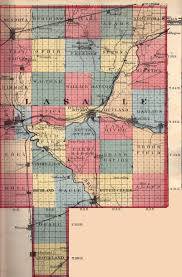In seeking out information about the Adams Family, I found an interesting article about Troy Grove and Ophir Townships in LaSalle County, Illinois. These are the areas in which Alexander and his son Franklin Adams owned farms.
“The Past and Present of LaSalle County, Illinois,” written by William Achotz and published in 1877, just two years before Alexander and his family departed Illinois, has the following information on page 474:
“Alexander Adams came to this country in 1854, and has lived here for 23 years. His son Franklin Adams lives on an adjoining farm.”
“This country” in the book, undoubtedly referrs to Alexander’s arrival from Wayne County, Ohio and not any immigration from another country. The reference in Achotz’s book was within the section marked Mendota, since Alexander Adam’s mailing address at that time was Mendota, Illinois. Since his family is found first in Troy Grove Township in the 1860 US Census and in Ophir Township in the 1870 US Census, there is no doubt that they first lived in one and then removed to the other.
Here’s the historical information:
The History of Troy Grove, LaSalle County IL
Transcribed by Nancy Piper
Homer or Troy Grove
Homer or Troy Grove is the oldest village in this part of the county. It was laid out in 1836 by Kirtland and Colton who purchased the land of R. H. Wixom, who had entered it the year previous. Colton was a native of Homer, New York and named the village in honor of his native place. William A. Hickok, father of the famous James B. Hickok, “Wild Bill,” opened the first store on the town site, and here, in a rude dwelling, his noted son was born. The nearest town was Peru, which for many years was the public mart. Mr. Hickok was shortly followed by James Newton Reedor, Justin D. Wixom and John Johnston, the latter of whom opened a small store soon after his arrival. The earliest settler in Troy Grove Township was Elias Carey, who located on section 21, in February, 1831.
The next May, Hiram Thornton joined him, these two being the only residents at the opening of the Black Hawk War. When danger became imminent, they removed to Fort Wilburn, opposite La Salle, and remained in its safety a few weeks, While there, Mrs. Carey gave birth to a son, Geo. W. – who, though not born within the actual limits of the township may claim to be the first white child born here. He still lives in Homer. Mr. Kelso had a cabin a short distance from the site of Homer, and here he opened a store before the village was laid out, and continued the sale of goods some time.
In 1835-36 a sawmill was erected by several of the settlers for their use, which was soon purchased by Reeder & Wixom, who sawed the lumber for the school house built in 1837. This primitive structure cost $205.00, and did good service for many years. The village of Homer grew well for several years. As there was another town by that name in the State, the post office was named ‘Troy Grove, which name it still hears. Until the commencement of Mendota, all trade for this locality carne to this town, and made a good business. Three or four stores were well supported, and an equal n umber of shops.
Mr. S. Frenburg, one of the oldest settlers in this part of the county, located here in 1849. At that time the trade was growing well, and continued so until Mendota was started. He removed there in 1859, where he still continues in business.
Many readers of these pages will remember well the letters of “Rural,” in the Chicago Tribune of late years. The writer of these was Mr. M. L. Dunlap, one of the first teachers in Troy Grove Township, the house wherein he taught being the first erected here. It stood on section 24, and was erected in 1834.
The small school house in town, already mentioned, was occupied until the erection of the present one. It is soon to be replaced by an elegant structure. The school district embraces a large area of country, and the attendance is hardly ever less than one hundred. The Presbyterian church of Homer is the germ of all Presbyterian congregations in this part of La Salle County. It was organized in 1849, with eight members. They were James and Mrs. Smith, A. Hoffman and wife, Mrs. Chapin, Mr. Nye and P. L. Porter and wife. The organization was effected at Batchelor’s Ridge, about four miles east of Homer, in a school house. The presiding minister was Rev. James S. Baldwin. The same year they built a church there, which they occupied until 1850, when they erected one in Homer, and “vent there for divine services. In the erection of both these houses they received important aid from Rev. Patterson, of Chicago. In 1857, this church, then the New School Presbyterian, was purchased by the old school body, who were immediately organized by the Rev. Henderson and Mr. Fisk. Rev. Henderson preached here and at Mendota during his life time. The old house, becoming unsafe, the congregation not long since erected their present comfortable structure. The membership is now about fifty, no regular minister being sustained.
The Free Will Baptist church was organized in the Presbyterian Church in the year 1860, with about fifty members, it being the result of a revival under the ministry of Rev. Coltron. They soon hall a comfortable church edifice built, which they still occupy. They do Hot sustain a regular pastor, but are regularly supplied from other localities. Several other churches have been started in Homer, but the majority have removed to other places, where they organized anew.
[The Past and present of La Salle County, Illinois : containing a history of the county, its cities, towns, &c., a biographical directory of its citizens, war record of its volunteers in the late rebellion, portraits of early settlers and prominent men, general and local statistics, map of La Salle County, history of Illinois, Constitution of the United States, miscellaneous matters, etc, etc.. Chicago: H.F. Kett & Co., Ottaway & Colbert, printers), 1877. Page 347-349]
HOMER VILLAGE
The village was laid off in 1836 by a Mr. Colton in the center of his farm of 160 acres. He and the Wixoms may be considered the first settlers. Other early settlers were J. N. Reeder, Richard Maloney, Asa Mann, W. K. Dewey, Charles H. Gilman, R. Goddard, R. V. Temple, Alonzo Hickok, Dr. James Adair and John Johnson. The first store at Homer was opened in 1836 by Alonzo Hickok. He was followed successively by John Johnson, Fleming & Welch, Chapman & Baldwin, Baldwin, Adams & Lake and Bald win & Adams. At the same time that the last-named were in business, a second store was started by D. D. Guiles, and a third was run for a short time by one Warner. Guiles sold to J. D. Abrahams and Dr. Frank Edwards, while W. K. Dewey bought out Baldwins & Adams. Edwards sold his interest to Abrahams. The latter soon sold back to Edwards and went to Minnesota. Returning thence after a year or so, he bought out Dewey. Edward’s store was then made into a shoe shop. Abraham’s was succeeded by Krausse & Gerlach, the latter of whom soon retired. Chris. Krausse has since been alone, except for a time that he was in partnership with his brother. Gerlach started a second store, and shortly sold to John Eck, who in turn disposed of his business to W. P. Wixom, who is still in business. There are now in the village two stores, two blacksmith shops and a mill.
The population of Horner is now not far from 200. In the spring of 1884 incorporation was talked of, but as a population of 300 was required by law, the project was abandoned. Many of the voters, too, were opposed to the step.
The only railroad in the township at present writing is the Illinois Central, a mile and a half from Homer, and the nearest station, Dimmick, is three miles distant. The Northern Illinois Railroad (a branch of the Northwestern) is now constructing a line through the township which will pass through the village and will be of great benefit to its business interests.
RELIGIOUS
There are now at Horner two churches. In the early days occasional services were held by all the leading denominations, at private houses and in school-houses.
The Presbyterians have been organized over forty years. Early members were W. K. Dewey, Ansel Dewey, Alonzo Hickok and others. The first pastor was Rev. Nahum Gould, who was followed by one named Lord. Succeeding him there was a period in which no regular services were held. Other early preachers ‘were named Baldwin, Henderson and Fleming. Of late years the church has been rather inactive but since 1883 it is visited on alternate Sundays by Rev. G. A. Pollock, of Mendota. They have a neat frame church, built in 1867 at a cost of $1,600.
The Church of God was started here about 1852, and thrived for a time. They built a small house of worship, which was afterward used by the Methodists, then by the Presbyterians, and is now in ruins. The Baptist society was organized by Elder Cyrus Coltrin, who settled here nearly thirty years ago. The first members were Mrs. Mary M. Firestine, Mrs. Priscilla Reeder, Mrs. Elmira Mitten, :Mrs. Mary J. Gibbs, Mrs. Bethia Welch, Dr. R. B. Mahannah, Cordelia A. Mahannah, John Dash and wife, John Peters and wife, William Brown and wife Pamella, John Killing, Ceph. Higgins, and others-twenty-eight in all. After Elder Coltrin, who was here four years, the pastors have been named F. P. Augur, Bryant, Allen (a Winebrennarian), Moses Gunn, Newcomer (also a Winebrennarian), C. J. Chase, and the present minister is Rev. J. S. Dinsmore, who holds service on alternate Sundays. The church was erected soon after the organization of the society, at a cost of $1,500. The membership is now about forty. Sunday-school meets regularly, under charge of Robert Moore or William A. Wilkins. The average attendance is from fifty to sixty.
The Methodists had a minister located here (Rev. Mr. Foreman) for some years. A class was formed by John Johnson and son George W., John Simpson, W. K. Dewey , Jesse Wixom and others. Stephen McPherson and William Maddox were prominent members later. Services were discontinued soon after the war.
MASONIC.
Shiloh Lodge, .No. 39’7, F. & A. H., was organized under dispensation in 1863, and its charter was dated Oct. 5, 1864. The charter members were H. C. Gibbs, Lewis Miller, W. J. Campbell, A. Higgins, W. W. McLaughlin, C. McLaughlin, B. O. Lampson, A. McLaughlin, O. G. Gibbs, W. Maddox, William Simpson, Jerry Geft, Daniel Carr, Milton Salyards, R. Kaupp, David McLaughlin, H. C. Gibbs (first W. M.), Lewis Miller (first S. W.) and W. J. Campbell (first J. W.), The present officers of the lodge are: John C. Schempp, W. M.; Fred Meinhard, S. W.; James Peters, J. W.; Frederick Zorn, Treas.; George Herger, Sec.; John Wilshay, Tyler. The present membership is seventeen.
POST OFFICE
The post office of Troy Grove, at Homer Village, was established in 1837. James N. Reeder was first Postmaster, receiving mail once a week. The route was from Peru to Dixon. Win. K. Dewey succeeded Mr. Reeder. Then came M. D. Masterman, who died in 1861. Then Charles F. Foster was made Postmaster, succeeded by his wife, Mrs. Harriet (Masterman) Foster, who held the office in 1885, her husband carrying the mail tri-weekly to Mendota and return.
IMPROVEMENTS
The first improvement of the water-power at Homer was made by James N. Reeder, who built a saw-mill, which to the early settlers was a great convenience. Though the power was limited he did a thriving business for a few years. Mr. Reeder sold to Elisha Miller. The dam was swept away in 1847, and the property remained idle until 1857, when Michael Meinhard bought the property and slowly improved the same. In 1861 he built a gristmill, opened for business in 1862. Later, the power failing, he was compelled to put in steam-power. The property was in 1885 operated by his son, Fred Meinhard, and is fitted with two sets of burrs and two sets of rollers. The mill is 40 x 34:, two stories in height, and solidly built of Homer stone.
PHYSICIANS
Dr. James Adair was the first resident physician. He was a well-educated Ulan, but he became a fanatical convert to spiritualism, his mind was unbalanced and he committed suicide in Mendota in 1881. Dr. Newcomb was the second resident physician. He was well educated but not of good habits. He died on his way to California on the plains, a victim of gold fever. Dr. R. B. Mahana located here in 1848. He was killed in 1882, near Rochelle, Lee County, by a mowing machine. Dr. Arnold practiced in the early years a short time. Dr. Frank Edwards practiced here about four years, and Dr. Gilbert came in the “fifties,” afterward going into the army. Dr. G. W. Houtz was long a resident physician; he is now a resident of Lincoln, Neb. Dr. Milton Everts was in 1885 the resident doctor. He established himself here in 1874. He was born in Clinton County, N. Y., July 2, 1846; studied first under Dr. Edwards at :Mendota, later graduated from Rush Medical College, Chicago. Has attended College of Physicians & Surgeons in New York City, and received a diploma from Jefferson Medical College at Philadelphia.
[Source: History of La Salle County, Illinois : together with sketches of its cities, villages and towns, educational, religious, civil, military, and political history, portraits of prominent persons, and biographies of representative citizens : also a condensed History of Illinois, embodying accounts of prehistoric races, aborigines, Winnebago and Black Hawk wars, and a brief review of its civil and political history.. Chicago: Inter-State Pub. Co., 1886.Page 630-634- Transcribed by N. Piper]


